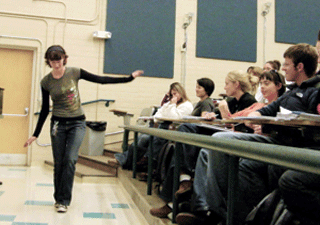Physics Teaching as a Performing Art
Brian Jones
You Are a Performer
We are what we pretend to be, so we must be very careful what we pretend to be.
Kurt Vonnegut, Mother Night
Some years ago I took part in a workshop on "Teaching as Performing" led by Morris Burns of Colorado State’s Department of Music, Theater and Dance. Morris started with a simple premise: When you teach, you are performing. You make choices about your costuming, your set, your gestures, your language, the stories you tell. He advised us to think about our goals as teachers, and then to make conscious, deliberate choices about all of these elements and more.
I was skeptical. But he ended the workshop with a very practical suggestion that showed me that he was, in fact, correct.
Arrange for a Critique
Morris suggested that we arrange for a critique, that we have someone who knows a bit about performing come to a class to observe and critique—not our pedagogy, but our performance.
I took his advice, and had a performer friend watch me teach. He made a very unusual suggestion: He told me to stop writing on the blackboard. "When you are solving problems," he said, "That’s when your students feel the most uncertain. That’s when they need you the most. And you turn your back on them." He suggested that I use an overhead projector and write on transparencies, so that I always face the class. And so I did.
That single change made more of a difference in my lecture teaching than anything else I have ever done. When I used the overhead instead of the blackboard, not only was I facing the students—which they noticed and appreciated—I could watch them, to see their reactions, and tailor my teaching to suit.
Ask someone who knows a bit about performing to watch you and observe all of the cues that you give—to critique your performance. You might be surprised at what they suggest!
We all know that lecture isn’t the best way to teach students. But if you have a large class, you will probably spend much of the time lecturing. You will be performing. As long as you are on stage, you might as well put on a good show.
Setting the Stage
The only thing that doesn’t change, makes everything else rearrange
Is the speed of light, the speed of light
My love for you must be the speed of light
- Julie Miller, The Speed of Light
I teach in a large lecture hall. Some years ago, one of my students noted that the lecture hall had a great sound system. Could I, he asked, play music before class?
I could, and I did. This popular change had two very practical benefits. First, I could play music that related to the day’s topic. Students would listen for this, and appreciate it. But—perhaps more importantly—I can time the music so that it fades out precisely when class is to start. Students know that when the music stops, class begins. That’s a great way to lead off.
Once you—and your students—start looking for good songs, you’ll find that there are some really great ones out there.
This wounded world keeps spinning
Turns me over, upside down
I should be thrown into oblivion
But gravity’s got me down, down, down.
- Friction Farm, Gravity
I teach in front of a large screen on which I project a series of slides. A few years back, I realized that most of the time my slides consisted of bullet points and equations. That’s fine, of course, but it’s really underutilizing the medium.
My projector can display a full-color image four meters high. It can show movies. It’s got a great sound system attached. I realized that I should use the power of the projector to show things I couldn’t have shown on an overhead projector.
These days, I show video clips regularly. I use simulations. I use animations. And when I introduce a topic, I always do so with a compelling image that sets up the topic I am about to begin. With cheap digital cameras, downloadable video clips, online image sources and full-featured presentation software at my disposal, I’ve realized that it was time for me to move beyond using the projector as a glorified overhead projector.
Sharing the Stage

A slide from my second lecture on optics. Humans have red eye; dogs have eyeshine—a great way to introduce reflection from thin films..
As often as possible, I like to share the stage with students. My favorite way to do this is via something I call "Physics Theater." I ask students to come in front of the class and, truly, perform.
On the day when we talk about angular momentum, I invite three students to stand in a line in front of the class. "Imagine," I say, "you are standing on the edge of a tall building. I give you a push, and you try—hard—not to fall off. Make us believe that you are in danger of falling, that you are trying hard not to." And then I give them each a shove, and we watch what they do. 95% of the time they windmill their arms—spinning them forward, thus rotating their body backward.
I then follow up with a great video clip of someone doing just this on Skylab. Arms rotate forward, body rotates backward.
This is a great way to introduce the concept of angular momentum, but, more than that, it’s a great way to get students involved. My willingness to let students be the stars once in a while really breaks down barriers.
Telling a Story

A slide from the first class on electric fields and forces.
We physics educators have a strong tendency to "bury our lead." We write equations, we do derivations... and, at some point, we get to the stuff our students really care about, a connection to the way the world works.
Pretending to walk on a tightrope high above a city street. Why does everyone extend their arms?
When I teach my students (who mostly major in the bio sciences) about electric fields, I start with an interesting fact: The animal with the biggest brain in the world isn’t us. As far as I can determine, it’s a weakly electric fish from turbid rivers in Africa.1 This raises some interesting questions—How does a fish make an electric field? How does this allow it to find prey? And why does this require such a big brain?—that we can return to as the topic unfolds.

A slide from the first class on electric fields and forces.
If you are using pictures to help tell your story, you need good pictures. The photo in this slide came from www.flickr.com. This and other photo sites have a remarkable range of photos, many available under a Creative Commons license. Such photos can be reproduced and distributed as long as you don’t earn any money (as educators, this is a danger we easily avoid) and as long as you credit the photographer.
Using Props
We all use lecture demonstrations—these are our props. But I’ve always felt that I should be doing a better job with them. When I watch someone who’s really good at presenting a demonstration, like Stan Micklavzina of the University of Oregon, I can tell he’s put a lot of thought not just into what he’s doing, but how he does it.
I’ve learned a lot from watching other physics folks, but I’ve learned just as much from watching magicians. When you watch a really skilled magician, he makes you look just where he wants. When something happens, you notice. You are waiting for it. And you’re surprised.
Why should we do any less when we present a lecture demonstration? Think about your staging, your presentation, your timing. And practice. You are, after all, a performer. You might as well be a good one!
The Upside
After a few years of putting real effort into classroom presentations, I see changes in class attendance, interest level, engagement level—and in the level of understanding.
When I first started making changes in my class, I was skeptical that these changes would make a difference. But they do, and not just because my students are more likely to be in class and be awake.
As one of my students noted, classes made her "want to care." If I play the role of an active, interested, engaged instructor, my students are more likely to play the role of active, interested engaged scholars. And that’s got to be good.
1. Nilsson, G. Brain and Body Oxygen Requirements of Gnathonemus Petersii, a Fish with an Exceptionally Large Brain. The Journal of Experimental Biology 199, 603–607 (1996)
Brian Jones is best known as the Director of the Little Shop of Physics, an outreach program of the Physics Department at Colorado State University.
This article is not peer refereed and represents solely the views of the author and not necessarily the views of APS.
